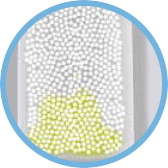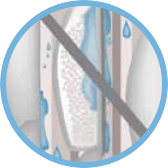
Hybag
Hybag desiccant bags offer maximum protection against moisture damage in a small, easy-to-use package.
DESICCANT BAGS
Hybag absorbs more moisture while taking up less space than the average container desiccant, thanks to its breathable membrane technology and fast-acting gel formula.

Maximum Absorption

High-Tech Breathable Fabric

State of the Art Fastening System

Zero Leakage—Guaranteed
Specialty designs for maximum absorption
Choose from four specially designed models based on your unique shipping needs. No matter your selection, you can expect the same high absorption capacity in all shapes and sizes.

Hybag Square

Hybag Strip

Hybag Eco

Hybag Flat
Equipped with a state-of-the-art hook install system, installation is simple and straightforward. How else can we support your shipping operations?
FREQUENTLY ASKED QUESTIONS
What is a desiccant bag?
A desiccant bag is a product designed to absorb moisture from the air. These semi-permeable bags are filled with a highly absorbent that draws moisture from the air.
Desiccant bags are typically used to remove humidity that might damage or degrade products. Because desiccant materials can passively capture and store moisture, they’re found in all manner of consumer products—from dry foods to shoe boxes.
In logistics, desiccant bags act as a form of shipping container moisture control. Container desiccant bags are specifically designed products that keep the air inside a shipping container dry, even during multi-week crossings.
How can desiccant bags protect shipped goods?
Moisture is an inevitable part of shipping products around the world. The ocean is a naturally moist environment, and most ports have a humidity range of 68–81%. Between the transoceanic voyage and the time spent waiting at port (which can increase due to labor shortages, strikes, or seasonal volume), many cargo shipments remain in high-moisture conditions for several weeks. Moisture is also a concern for land and air shipments.
To protect the goods inside containers for long periods, logistics companies use a shipping container desiccant. Desiccant bags for shipping containers draw in moisture from the interior air of the container, helping to absorb and hold water particles to prevent container rain or container sweat.
Both small and large desiccant bags can be used as dehumidifying agents in a shipping container. Smaller solutions are ideal for filling the spaces between goods, while larger moisture absorbers for shipping containers can substantially lower the humidity level inside a container.
What causes container rain and container sweat?
The primary cause of moisture damage in shipping containers is “container rain.” Container rain can happen when the outside of a shipping container becomes cooler than the inside, most often when the external temperature drops at night. The water vapor inside the container cools when it comes into contact with the metal, and condensation forms.
As this moisture accumulates on the container roof, it can rain down on the products within and cause moisture damage.
“Container sweat” is a similar phenomenon that causes residual moisture in the air to accumulate on the walls of the container. This condensation can affect any goods touching the sides or bottom of the shipping container.
Container desiccant bags eliminate the risk of container rain and sweat by removing as much moisture from the air as possible. As long as a sufficient number of desiccant container bags are used, shipping containers can be almost entirely moisture-free, though some amount of condensation (especially in colder climates) is inevitable.
What is Hybag?
Hybag is a line of moisture bags for containers used to ship goods around the globe. Choose Hybag products in a variety of shapes and sizes to suit your shipping needs. Select from:
- Hybag Square
- Hybag Plus+
- Hybag Strip
- Hybag Eco
- Hybag Flat
All Hybag container desiccants are crafted using breathable membrane technology designed to offer ultimate absorption capacity. For a shipping container condensation eliminator that’s effective and easy to use, look no further than Hybag.
Are Hybag products easy to install in a shipping container?
Hybag shipping container desiccant bags come with a state-of-the-art hook that makes for easy installation. Protecting your cargo is a simple, straightforward process; with Hybag, you can add desiccant bags to your shipping container in seconds.
What are the benefits of using desiccant bags for container shipping?
When you use a desiccant, containers and their contents stay dry—it’s that simple. Approximately 10% of containerized goods are destroyed by moisture damage each year, and companies have to accept this loss as a “cost of doing business.” A desiccant solution can improve profits per container and reduce losses.
Even if container rain or sweat doesn’t entirely ruin the goods within, it can still lead to product quality issues, especially with food and pharmaceuticals. Desiccant bags ensure that the contents of a shipping container arrive in the same condition they left in.
Are desiccant bags safe to use?
The material inside of a typical desiccant bag is non-toxic and safe to handle. Plus, when the desiccant is kept in a desiccant storage container or pouch (as is the case with Hybag), it does not come in direct contact with the product in the shipping container. The perforations in a desiccant bag are large enough for moisture to enter but small enough that the desiccant material does not escape.
Even in shipments of raw ingredients or food products, you can safely deploy bags of desiccant for shipping containers. As long as a food-grade desiccant is used (and the material inside the bag is not ingested), there’s no risk for the end consumer.
How do you dispose of desiccant bags?
Unless otherwise noted by the manufacturer, moisture bags for containers can be discarded as regular waste.
However, it’s important to note that packaging desiccants can absorb more than just water. Desiccant bags for shipping containers can draw in other forms of moisture from the air. If you believe your chosen form of container condensation prevention may have absorbed a hazardous chemical during transit (for example, if you transport chemical products), you may have to dispose of the desiccant bag as if it were chemical waste.


